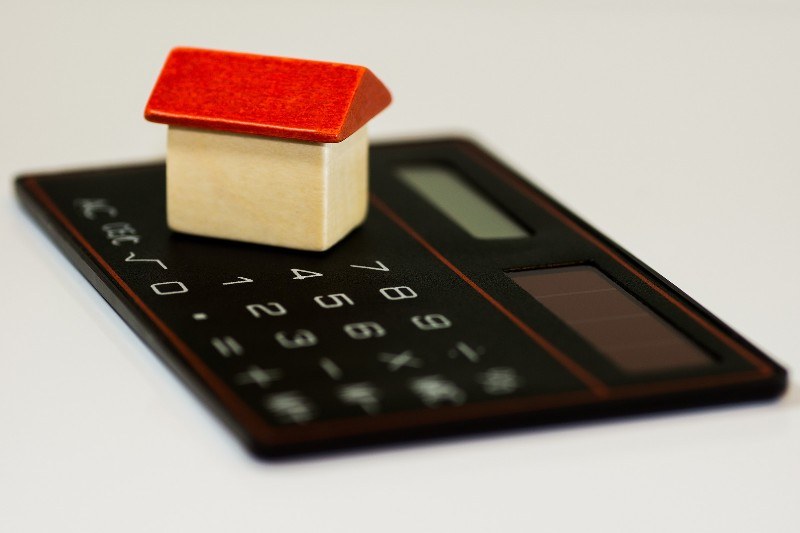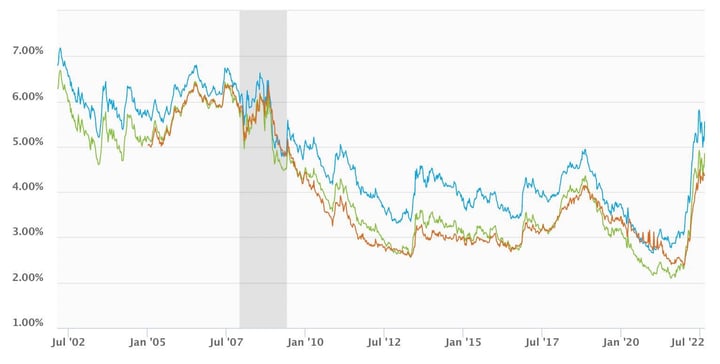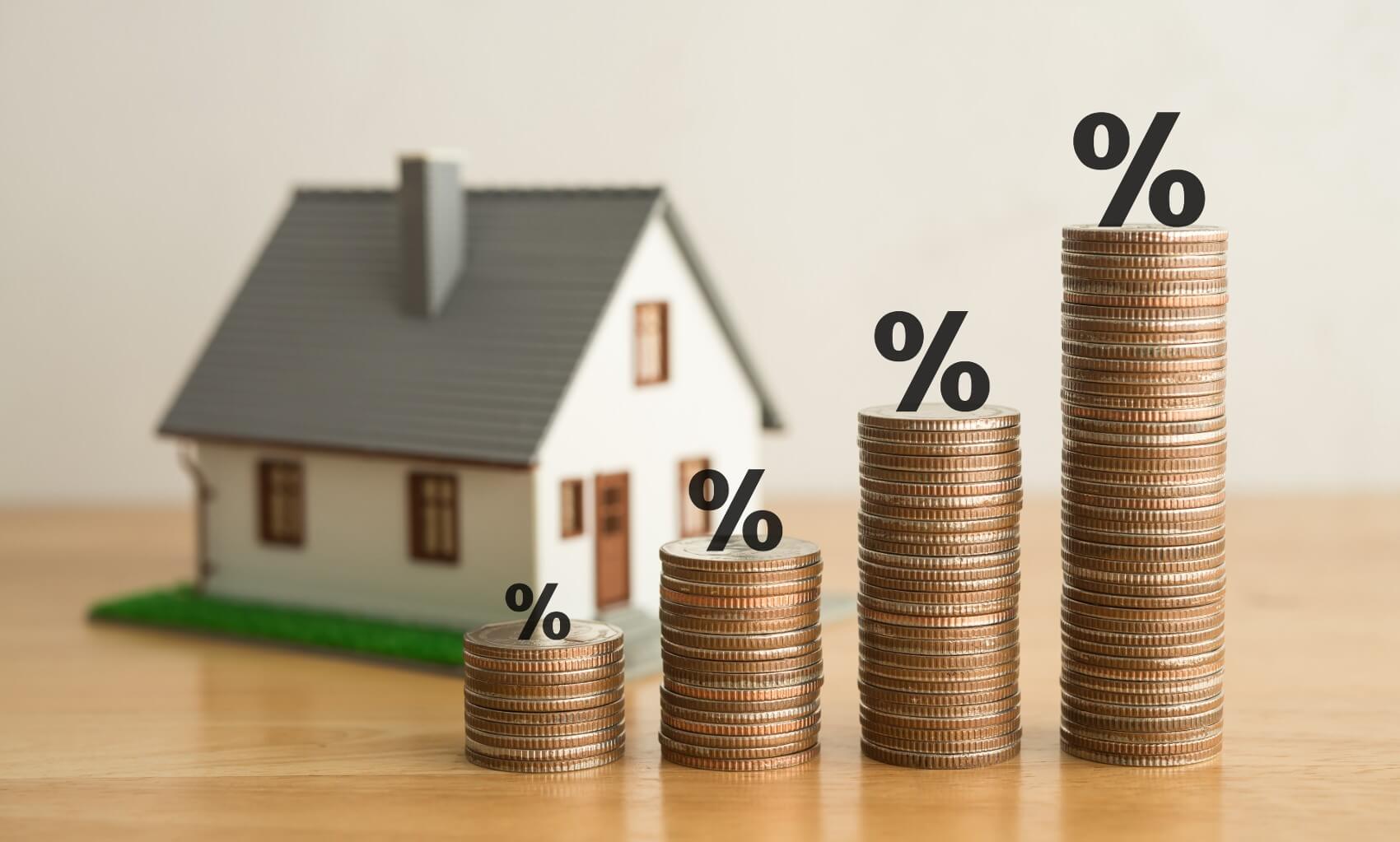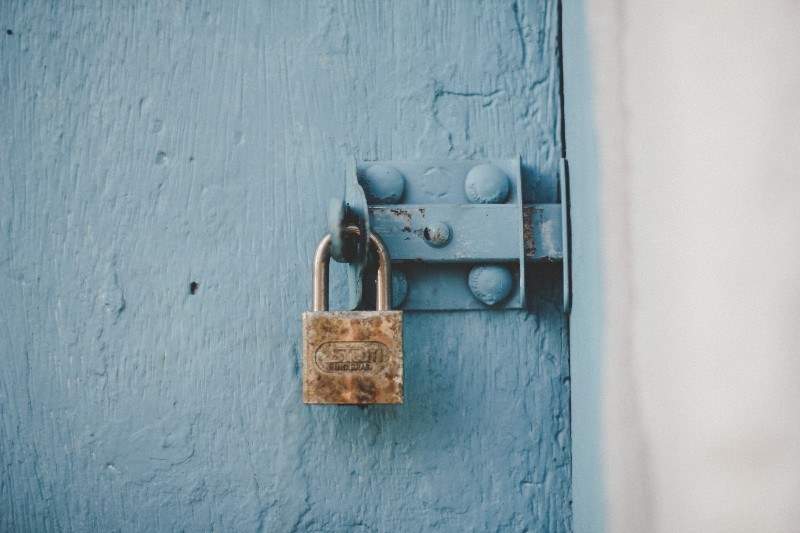
Should I Wait to Buy a House? What a Higher Mortgage Rate Means
Posted on Aug 31, 2022
Mortgage rates have been on a journey this year - and it’s the sort of journey that makes buyers...

Posted on Aug 31, 2022
Rates have risen to historic highs, and we're not sure they're coming back down anytime soon.
Read on to understand the mortgage rate, as well as ways you can get a lower mortgage rate (that go beyond just waiting and hoping).
The mortgage rate determines how much interest you pay on your home loan amount. When the rate is low, borrowing is cheap - allowing homebuyers to buy larger homes. When the rate is high, borrowing is expensive, limiting how much house homebuyers can afford.
When we talk about "the rate" we're really talking about an average number that buyers are quoted, because each lender delivers a slightly different rate - even to the same person (which is why it pays to shop around for lenders! At Houwzer, we do it for you).
Several market factors influenced the mortgage rate.
"Mortgage rates follow the 10 year U.S. treasury, and when the Federal Reserve moves the short term rate higher depending on other economic factors, mortgage rates can drop," explains Garville. "This has happened recently. Once the Fed went public with what the plans are for the year, mortgage rates dropped - just follow what the 10 year U.S. treasury does, as that will dictate what mortgage rates will do."
The 10-year U.S. treasury note is a debt obligation issued by the U.S. treasury that matures after 10 years. Until then, interest is paid out at a fixed rate. Though it closely follows the 10-year U.S. treasury, in actuality the mortgage rate is tied to the bond market. And the bond market is comprised of mortgage-backed securities. When the stock market is performing poorly, demand for mortgage bonds increase - pushing mortgage rates up.
If this all sounds confusing, the main thing to know is that mortgage rates tend to rise and fall in response to the state of the overall U.S. economy.
And if you're worried about rates rising or falling, keep in mind that rates actually fluctuate on a monthly, weekly, and even daily basis.
"Mortgage rates always have small moves in pricing and usually don't move more than .125% on the high end. Sometimes when we have bad economic news or a geo-political event, rates can move even higher. We have seen times where rates have gone up .75% in a day but that does happen very often," explains Garville.

Not loving your quoted mortgage rate? There are a few things you can do to lower it.
"The options for getting a lower rate when ready to lock in are limited to: buying a rate down - you can pay points to get to the rate you want; adjustable rate loans that have lower starting rates; and there is a loan program called a 2-1 buydown, which gives you a start rate for the first year 2% below the note rate, in the second year it's 1% below the note rate, and in year three you are at the note rate," outlines Garville.
Here's how they work.
Buy your mortgage rate down. If you have cash on hand, you can lower your mortgage rate by buying points from the lender. A mortgage point is typically equal to about 1% of your loan amount - so for a $400,000 loan, you’d have to pay $4,000. A mortgage point is not the same as 1% of your mortgage rate, however. With one point, you’ll see your rate lower by about .25% (give or take).
Generally speaking, this route is worth it if you plan to stay in your home for a while. If you only plan to live in your home your home five years or so before selling, on the other hand, then it might prove more cost-effective to put that money in your down payment.
Using Bankrate’s mortgage calculator, let’s walk through an example.
Say you plan on buying a $500,000 house with 10% down, meaning your loan amount would be $450,000.
If you decided to buy two mortgage points, they would cost 2% of the loan amount, or $9,000, and your mortgage rate would go from approximately 4.36% to 3.86% (since you reduced the rate by .5%)
So: buying two mortgage points upfront would net you $38,254 over the length of your loan (compared to keeping the $9,000).
However, this equation relies on you staying in your home and paying off the mortgage for the full 30 years. If you sell your home after five years, putting that additional $9,000 toward the down payment pays off the loan fastest, while buying points to lower your score results in the highest remaining loan balance.
In this 5-year scenario:
If this seems confusing, the key takeaway is that buying down points is most beneficial when you plan to live in your home longterm, because it knocks money off from each payment you make. If you sell your home in under 10 years, though, the gain might be quite marginal - if there is a gain at all.
Keep in mind that this is only a hypothetical scenario - so it always makes sense to consult with a mortgage advisor to find the most financially appropriate solution for your situation. Loan points, for example, are not exactly .25% off your mortgage rate each time - they can also fluctuate depending on market factors.
You can also get a lower mortgage rate if you pre-emptively take takes to improve your credit score before approaching lenders. For this, it’s a good idea to talk to a mortgage advisor before making any moves - or at least thoroughly do your research.
Closing your credit cards, for example, can actually lower your credit score because average age of accounts and credit utilization (what percentage of what you can borrow) both count toward credit score. Calling your credit card company and asking them to increase your limit can help improve your score, rather than getting rid of your card.
For more tips, visit Can I Buy a House With Bad Credit?
What is an ARM? As the name suggests, Adjustable Rate Mortgages come with floating interest rates that follow an index, rather than the set rate that comes with a fixed mortgage. The rates are adjusted every 3-12 months, depending on the terms of the loan.
ARMs (also known as variable-rate mortgages) got a bad rap thanks to the 2008 mortgage crisis, but numerous regulations were put into place after the last housing crash ensuring that homeowners are qualified to take out their loans, and know what they’re getting into.
Combination mortgages, where a loan starts at a fixed rate then switch to an ARM after a number of years, are popular: a 5/1 ARM, for example, has a fixed rate mortgage for the first five years before switching to an adjustable rate.
An adjustable rate mortgage can actually be a smart financial choice for someone who isn’t planning on staying in their home for the entirety of the mortgage. As of this writing, the average fixed mortgage rate is 5.94% while the current average 5-year ARM rate is 4.89%. So if you know that you’re likely to resell your home within the next five years, opting for an ARM can give you a lower interest rate today - allowing you to qualify for more house, or lower monthly payments.
An ARM typically has a 1-2% lower start rate than the traditional fixed-rate loan. There is also an option for a 7/1 ARM, which allows you 7 years of a fixed rate - however, this won’t start with as low an interest rate as the 5/1 ARM.
A 2-1 buy down is similar to an ARM in that it allows for a lower initial mortgage rate. For the first year, the rate is 2% lower - for the second, it's 1% lower. Then the rate is set to the permanent, full rate in the third year. This mortgage agreement is often paid for by the home seller (which is sometimes the home builder) to tempt buyers.
Buyers can also pay for a 2-1 Buydown. While it comes with a fee, it can be worth it if you expect your income to rise or your debt obligations to drop down after the initial two years - giving you a couple years before you need to start paying more per month.
Keep in mind that once you own a home, your mortgage rate is not set in stone.
If you plan on living in your home for a while, refinancing is one way to lower your mortgage rate. When you refinance, you receive a new mortgage rate - replacing the old one. So if you receive a rate of 6% now, then rates drop down to 3.5% a year from now, you can refinance to take advantage of the lower rate. In 2020 when rates dropped to record lows, repeat refinances ticked upward - 10% of all refinancers had done it at least once before.
It does come with a cost (on average, refinancing a mortgage costs between 2% and 6% of the loan amount), which is why this isn’t the best solution for someone who only plans on living in their home for a few years - it will take you several years before you make back what you spent on the mortgage processing fees.
You can also refinance from a 30-year mortgage to a 15-year mortgage. While this may raise your monthly payment amount, it will lower your rate - meaning that you spend less money on interest over time.
Subscribe to our newsletter to get essential real estate insights.

Posted on Aug 31, 2022
Mortgage rates have been on a journey this year - and it’s the sort of journey that makes buyers...

Posted on Aug 31, 2022
Although many home searchers tend to hyper-focus on a home’s sticker price, the impact of the...

Posted on Aug 31, 2022
Rate locking is a topic that’s come up a lot recently as the mortgage rate climbs higher and...